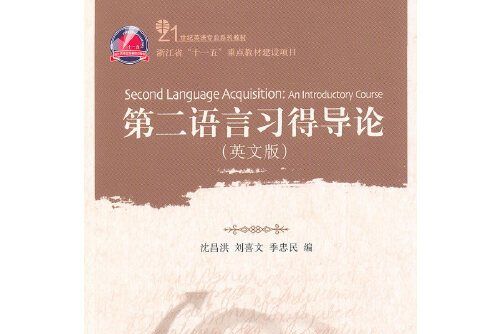《第二語言習得導論第二語言習得導論》是2010年6月北京大學出版社出版的圖書,作者是沈昌洪,劉喜文,季忠民,本教材適合高等院校英語專業本科生、研究生以及中國小英語教師學習和使用。
基本介紹
- 中文名:第二語言習得導論第二語言習得導論
- 作者:沈昌洪、劉喜文、季忠民
- 出版社:北京大學出版社
- ISBN:9787301171356
內容簡介,圖書目錄,
內容簡介
本教材以章節的形式論述國外“第二語言習得”領域近半個世紀以來的研究歷程。全書既全面、詳細地介紹語言習得的理論創建與發展、兒童母語習得過程、二語/外語學習理論以及二語課堂教學研究等方面的成果,又綜合、客觀地反映認知學、心理學、社會文化學等領域對第二語言習得與發展的不同視角與觀點。
本教材適合高等院校英語專業本科生、研究生以及中國小英語教師學習和使用。
圖書目錄
Chapter 1 Introduction: Key Concepts and Issues in SLA
1.1 Language Acquisition and SLA
1.2 Some Definitions of SLA
1.3 Some Structural Characteristics of SLA
1.4 The Literature on the Theories of SLA
1.5 A Theoretical Approach Proposed by Spolsky
1.6 Theoretical Applications to L2 Teaching and Learning
1.7 Some Distinctions in the field of SLA Research
1.8 Conclusion
Points for Thinking
Further Reading
Chapter 2 Views on Language, Learning and Learner
2.1 Views on the Nature of Language
2.2 Views of the Language Learning Process -- L1 versus L2
2.3 Views of the Second Language Learner
2.4 Conclusion
Points for Thinking
Further Reading
Chapter 3 An Introduction to Language Acquisition
3.1 Introduction
3.2 Developmental Patterns in L1 Acquisition
3.3 The Controversy between Behaviorist and Mentalist Models
3.4 Developmental Patterns in L2 Acquisition
3.5 Conclusion
Points for Thinking
Further Reading
Chapter 4 Recent History of SLA Research
4.1 Introduction
4.2 The Early Studies on Language Acquisition (to 1960s)
4.3 The Following-up Studies in 1970s and 1980s
4.4 The Recent Studies on L2A (beyond 1990s)
4.5 Conclusion
Points for Thinking
Further Reading
Chapter 5 The UG Approach to Language Acquisition
5.1 Introduction
5.2 Universal Grammar (UG) for Language Acquisition
5.3 Arguments from First Language Acquisition
5.4 What Does UG Consist of?.
5.5 Evaluation of UG-based Approaches to SLA
5.6 Conclusion
Points for Thinking
Further Reading
Chapter 6 Cognitive Approaches to SLA
6.1 Introduction
6.2 Two Main Groups of Cognitive Theorists
6.3 Processing Approaches
6.4 Connectionism
6.5 Theories of L2 Processing
6.6 Evaluation of Cognitive Approaches to L2 Learning
6.7 Conclusion
Points for Thinking
Further Reading
Chapter 7 Some Other Perspectives on SLA
7.1 Introduction
7.2 Functional Perspectives on L1 Learning and SLA
7.3 Functionalist Contributions to an Understanding of SLA
7.4 Sociocultural Perspectives on SLA
7.5 Sociolinguistic Perspectives on SLA
7.6 Conclusion
Points for Thinking
Further Reading
Chapter 8 Input, Interaction and Output in SLA
8.1 Introduction
8.2 Input and Interaction in L1 Acquisition
8.3 Input and Interaction in SLA
8.4 Output in SLA
8.5 Theorizing Input, Interaction and Output Research
8.6 Feedback, Recasts and Negative Evidence in SLA
8.7 Evaluation: The Scope of Interactionist Research
8.8 Conclusion
Points for Thinking
Further Reading
Chapter 9 Varied Perspectives on lnterlanguage
9.1 An Introduction to Interlanguage
9.2 Social Aspects of IL
9.3 Discourse Aspects of IL
9.4 Psycholinguistic Aspects of IL
9.5 Conclusion
Points for Thinking
Further Reading
Chapter 10 Researches on L2 Classroom Practice(I)
10.1 Introduction
10.2 An Introduction to the History of L2 Teaching Methods
10.3 Cross-language Competition between L1 and L2
10.4 Some Methods Used in L2 Classroom Research
10.5 Data Collection and Data Analysis
10.6 Conclusion
Points for Thinking
Further Reading
Chapter 11 Researches on L2 Classroom Practice(II)
11.1 Direct Involvement of Classroom Interaction Research
11.2 An Introduction to Classroom Interaction
11.3 Types of Language Use in Classroom Interaction
11.4 Turn Taking in Classroom Discourse
11.5 Differences between Classroom and Naturalistic Discourse
11.6 The Teacher's Role in Classroom Interaction
11.7 Learner Participation
11.8 Classroom Interaction in the L2 Learning
11.9 The Relationship between Classroom Interaction and SLA
11.10 Conclusion
Points for Thinking
Further Reading
Chapter 12 Conclusion
12.1 A Brief Review of the Book
12.2 An Integrated View of SLA Research
12.3 Main Achievements of Recent SLA Research
12.4 SLA Research and Language Education
12.5 Future Directions for SLA Research
Points for Thinking
Further Reading
REFERENCES

